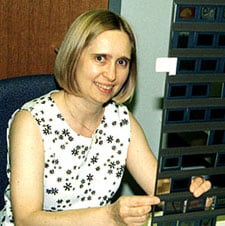
Title
Professor Emeritus
Associate Director, AR INBRE (Arkansas INBRE)
Director, AR INBRE Developmental Research Project Program
Ph.D.
University of Arkansas for Medical Sciences
Curriculum Vitae: Word
Email: beneshelen@uams.edu
Address: Office: Shorey Building Rm. 938
University of Arkansas for Medical Sciences,
Slot 510
4301 West Markham St.
Little Rock, AR 72205
Phone: Office: 501-686-5782; Lab: 501-526-7146 and 501-526-7598
Fax: 501-686-6382
Research Interests
Research in the Beneš laboratory focuses on two separate topics for which insect models are used to elucidate processes with relevance to human development, aging and disease. Specifically, the female-specific transcriptional regulation of a hexamerin gene (Hex-1.2) activity is studied in mosquitoes using standard molecular biology and transgenic techniques. The main function of hexamerins (hexameric storage proteins of insects) is to provide amino acid pools during non-feeding stages of development. However, in a number of insect species, hexamerin storage and utilization is related to reproduction, specifically the protein-synthetic phase of oogenesis or vitellogenesis. Recently, we showed that the doublesex (DSX) transcription factor plays an important role in the upregulation of Hex-1.2 activity in female mosquito larvae (Jinwal et al., 2006). With the cloning of the mosquito DSX factor, the search is now for interacting proteins that could mediate sex-specific chromatin remodeling as well as specific repressors of Hex-1.2 activity in males.
In collaboration with the Zimniak laboratory (Depts. of Pharmacology & Biochemistry, UAMS), we are examining the role of oxidative stress, specifically lipid peroxidation resulting in electrophilic stress, in both aging and tissue degeneration. The fruit fly, Drosophila melanogaster, serves as an ideal model organism to use genetics, molecular biology and biochemistry to study the role of detoxifying enzymes such as glutathione transferases (GSTs). The central hypothesis of one of our studies is that 4-hydroxynonenal (4-HNE), a major reactive α,β-unsaturated aldehyde and product of lipid peroxidation, contributes to the cellular damage involved in aging. We have shown that increasing the capacity for 4-HNE metabolism by overexpression of specific GSTs extends lifespan in the nematode, Caenorhabditis elegans (Ayyadevara et al., 2005a, b). Recently, in Drosophila we were able to show that tissue-specific targeting of 4-HNE-metabolizing activity is critical to the extension of life span. Targeting of specific GST activity to the highly aerobic flight muscles produces a significant extension of lifespan, in contrast to neural targeting which appears to have little effect.
Work on Drosophila GSTs has allowed us to isolate a mutant for the single GstS1 gene whose product is most abundant in the flight muscle of adult flies. Insect flight muscle exhibits several properties in common with mammalian cardia muscle and serves as a model to study Null GstS1 mutants are flightless and exhibit very rapid and specific flight muscle degeneration. Using genetic and transgenic approaches, we have shown in collaboration (Whitworth et al., 2005) that targeted expression of GSTS1-1 is critical to protection of dopaminergic neurons in a Drosophila model of Parkinson’s disease. We are now exploring the role of GSTS1-1 in the flight muscles and are considering roles both in electrophile detoxification and muscle contraction.
Selected Publications
- Singh, S.P., J.A. Coronella, H. Beneš, B.J. Cochrane and Zimniak, P. (2001) Catalytic function of Drosophila melanogaster glutathione S-transferase DmGSTS1-1 (GST-2) in conjugation of lipid peroxidation end products. Eur. J. Biochem. 268(10), 2912-23.
- Zakharkin, S.O., V.V. Sitnikova, N.K. Kumar, N.A. Buck, D.E. Wheeler and H. Beneš (2001) Female-specific expression of a hexamerin gene in larvae of an autogenous mosquito. Eur. J. Biochem. 268(22), 5713-5722.
- Sawicki, R., S.P. Singh, A.K. Mondal, H. Beneš, and P. Zimniak (2002) Cloning, expression, and biochemical characterization of one Epsilon-class (GST-3) and ten Delta-class (GST-1) glutathione S-transferases from Drosophila melanogaster, and identification of additional nine members of the Epsilon class. Biochemical J. 370(2), 661-669.
- Zakharkin, S.O., R.L. Willis, O.V. Litvinova, U.K. Jinwal, V.V. Headley, and H. Beneš (2004) Identification of two mariner-like elements in the genome of the autogenous mosquito, Ochlerotatus atropalpus. Insect Biochem. Molec. Biol. 34(4), 377-386.
- Whitworth, A.J., D.A. Theodore, J.C. Greene, H. Beneš, P.D. Wes, and L.J. Pallanck (2005) Increased glutathione S-transferase activity rescues dopaminergic neuron loss in a Drosophila model of Parkinson’s disease. Proc. Natl. Acad. Sci. USA 102(22), 8024-8029.
- Ayyadevara, S., M.R. Engle, S.P. Singh, A. Dandapat, C.F. Lichti, H. Beneš, R.J. Shmookler Reis, E. Liebau and P. Zimniak (2005) Life span and stress resistance of Caenorhabditis elegans are increased by expression of glutathione transferases capable of metabolizing the lipid peroxidation product 4-hydroxynonenal. Aging Cell 4(5), 257-271.
- Ayyadevara, S., A. Dandapat, S.P. Singh, H. Beneš, L. Zimniak, R.J. Shmookler Reis and P. Zimniak (2005) Life span extension in hypomorphic daf-2 mutants of C. elegans is partially mediated by glutathione transferase CeGSTP2-2. Aging Cell 4(6), 299-307.
- Jinwal, U.K., Zakharkin, S.O., Litvinova, O.V., Jain, S., and H. Beneš (2006) Sex-, stage- and tissue-specific regulation by a mosquito hexamerin promoter. Insect Molec. Biol. 15(3), 301-311.
